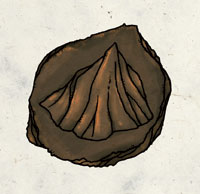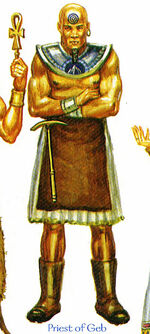Geb, (pronounced: /gɛb/ gheb[2]) also known as Gebthant in Thay and Gebakotep in Unther, was the eldest member of the Mulhorandi pantheon. Though once more curious and quick-tempered, he had mellowed since his birth to become a more cautious and even-tempered deity, slow to display emotion but appreciative of humor of all varieties.[1]
Description[]
Usually appearing as a Mulan human of regal stature, Geb typically wore an earth-colored robe known as a kalasiris as well as golden bracers and crown. Red eyes glowed faintly from the brown skin of his face, which often sported a beard cut short and braided. He typically kept a quarterstaff close at hand. In order to indicate a specific location to his followers, he might appear as an earth elemental in the region.[5]
Manifestations[]
Geb's will was often communicated through the acts of earth creatures such as stone golems and rust monsters, or those of animals such as bears and badgers.[5]
Those who displeased Lord Earth might experience an earthquake, while those who performed Geb's will might discover a cache of gemstones. Followers who planned to mine in unsafe regions might witness cracks forming in the ground and rock of the area to warn them.[5]
A follower of Geb might recognize the appearance of a dead canary to indicate unsafe air conditions, and the appearance of a fleeing rat as a sign that a mine or cave system might be unstable.[5]
Powers[]
Geb could summon earth elementals to his side, and could exert control over certain denizens of the Elemental Plane of Earth.[5]
Possessions[]
The avatars of Geb wielded an enchanted quarterstaff,[2][5] known as stonemantle.[2]
Relationships[]
Geb was the father of Isis, Set, Osiris, and Nephthys.[1] Other than Set, he remained on good terms with all his children. He also counted Flandal Steelskin, Grumbar, and Moradin as friends.[2]
Worshipers[]

The holy symbol of Geb.
Followers of Geb spent much of their time working within the earth, seeking to discover the treasures that lay beneath its surface, or working the materials that were found in stone. Clerics had to locate at least one new deposit of precious stones or vein of ore annually.[5] Divine spellcasters dedicated to Geb prayed for spells at midnight.[2]
Clerics of Geb typically painted a series of three blue circles on their shaved heads that serve as a symbol of their calling. They often colored their skin to a brown tint, and it was not uncommon for a member of the clergy to grow a short beard that was then braided. Usual vestments include a kalasiris, bracers, and iron-shod boots. These items were usually inlaid with small precious stones, and were often worn under a blacksmith's apron. Members of Geb's clergy favored heavy armor when preparing for a journey, and dressed as the occasion dictated.[5]
Church of Geb[]

A priest of Geb.
The position of a priest in the church of Geb was hereditary; members belonged to the House of Gebthant and who could claim at least one divine incarnation of Geb among their ancestors were viable. Geb's clergy was largely composed of humans native to Mulhorand, but both dwarves and gnomes would occasionally follow the teachings of the King of the Riches Under the Earth.[5]
Temples dedicated to Geb utilized natural geographic formations in their construction as much as possible. Most of these sites were built underground to better facilitate this decision. At least one temple existed in each mountain range within the range of influence of the nation of Mulhorand.[5]
Affiliated Organizations[]
- Fellowship of the Mithril Mountain: Charged with discovering the location of large mithril deposits, this order was composed primarily of traveling clerics of Geb.[5]
- Brotherhood of the Pick: The members of this order served as a representatives of the miners and craftsmen of Mulhorand, presenting their needs and wants to the nobility.[5]
The church of Geb supported no known combat-oriented organizations.[5]
Celebrations & Festivals[]
- Hidden Gift and Bountiful Joy: Clerics of Geb had to bury a precious stone or mineral each evening, which was then unearthed the following morning. These acts commemorated Geb's gifts to the earth and their eventual discovery.[5]
- The Unwrapping: Begun on the first of Mirtul, the Unwrapping celebrated nature's tendency to uncover the secrets of the earth on its own.[5]
- Day of Drawing Down: In memory of those that died within the earth over the past year, one or more abandoned mines were collapsed on the last day of Nightal.[5]
History[]
Geb was the first child of the deities Shu and Tefnut. He wed his sister, Nut, and they had four children. The two were forcibly separated when Geb was ordered to join the Mulhorandi pantheon on Toril.[1]
During the First Empire, Geb was considered an intermediate deity and his church flourished. However, due in part to inaction on the part of his clergy, Geb received little respect by the mid–14th century DR.[5]
Geb led his most faithful followers in building the Golden Forge during the Time of Troubles in 1358 DR. This temple served to prevent the eruption of a volcano that would devastate much of Unther's coastal regions.[5]
Appendix[]
References[]
- ↑ 1.0 1.1 1.2 1.3 1.4 1.5 1.6 1.7 Eric L. Boyd (September 1997). Powers & Pantheons. Edited by Julia Martin. (TSR, Inc.), p. 99. ISBN 978-0786906574.
- ↑ 2.0 2.1 2.2 2.3 2.4 2.5 2.6 2.7 Eric L. Boyd, Erik Mona (May 2002). Faiths and Pantheons. Edited by Gwendolyn F.M. Kestrel, et al. (Wizards of the Coast), p. 142. ISBN 0-7869-2759-3.
- ↑ Richard Baker, James Wyatt (March 2004). Player's Guide to Faerûn. (Wizards of the Coast), p. 157. ISBN 0-7869-3134-5.
- ↑ Hal Maclean (September 2004). “Seven Deadly Domains”. In Matthew Sernett ed. Dragon #323 (Paizo Publishing, LLC), p. 65.
- ↑ 5.00 5.01 5.02 5.03 5.04 5.05 5.06 5.07 5.08 5.09 5.10 5.11 5.12 5.13 5.14 5.15 5.16 5.17 5.18 Eric L. Boyd (September 1997). Powers & Pantheons. Edited by Julia Martin. (TSR, Inc.), p. 100. ISBN 978-0786906574.
- ↑ Sean K. Reynolds (2002-05-04). Deity Do's and Don'ts (Zipped PDF). Web Enhancement for Faiths and Pantheons. Wizards of the Coast. p. 11. Archived from the original on 2016-11-01. Retrieved on 2018-09-08.
Connections[]
Faerûnian Pantheon
Akadi | Amaunator | Asmodeus | Auril | Azuth | Bane | Beshaba | Bhaal | Chauntea | Cyric | Deneir | Eldath | Gond | Grumbar | Gwaeron | Helm | Hoar | Ilmater | Istishia | Jergal | Kelemvor | Kossuth | Lathander | Leira | Lliira | Loviatar | Malar | Mask | Mielikki | Milil | Myrkul | Mystra | Oghma | Red Knight | Savras | Selûne | Shar | Silvanus | Sune | Talona | Talos | Tempus | Torm | Tymora | Tyr | Umberlee | Valkur | Waukeen
The Morndinsamman
Abbathor | Berronar Truesilver | Clangeddin Silverbeard | Deep Duerra | Dugmaren Brightmantle | Dumathoin | Gorm Gulthyn | Haela Brightaxe | Laduguer | Marthammor Duin | Moradin | Sharindlar | Vergadain
The Seldarine
Aerdrie Faenya | Angharradh | Corellon | Deep Sashelas | Erevan | Fenmarel Mestarine | Hanali Celanil | Labelas Enoreth | Rillifane Rallathil | Sehanine Moonbow | Shevarash | Solonor Thelandira
The Dark Seldarine
Eilistraee | Kiaransalee | Lolth | Selvetarm | Vhaeraun
Yondalla's Children
Arvoreen | Brandobaris | Cyrrollalee | Sheela Peryroyl | Urogalan | Yondalla
Lords of the Golden Hills
Baervan Wildwanderer | Baravar Cloakshadow | Callarduran Smoothhands | Flandal Steelskin | Gaerdal Ironhand | Garl Glittergold | Nebelun | Segojan Earthcaller | Urdlen
Orc Pantheon
Bahgtru | Gruumsh | Ilneval | Luthic | Shargaas | Yurtrus
Mulhorandi pantheon
Anhur | Bast | Geb | Hathor | Horus | Isis | Nephthys | Osiris | Re | Sebek | Set | Thoth
Other gods of Faerûn
Bahamut | Enlil | Finder Wyvernspur | Ghaunadaur | Gilgeam | Lurue | Moander | Nobanion | Raven Queen | Tiamat
Greater Gods of Faerûn
Amaunator | Asmodeus | Bane | Chauntea | Corellon | Cyric | Ghaunadaur | Gruumsh | Kelemvor | Lolth | Moradin | Oghma | Selûne | Shar | Silvanus | Sune | Tempus | Torm
Gods of Faerûn
Angharradh | Auril | Bahamut | Berronar Truesilver | Beshaba | Garl Glittergold | Gond | Ilmater | Loviatar | Luthic | Malar | Mielikki | Sheela Peryroyl | Sseth | Talona | Tiamat | Tymora | Umberlee | Waukeen | Zehir
Exarchs of Faerûn
Abbathor | Arvoreen | Baervan Wildwanderer | Bahgtru | Baravar Cloakshadow | Brandobaris | Callarduran Smoothhands | Clangeddin Silverbeard | Cyrrollalee | Deep Sashelas | Dugmaren Brightmantle | Erevan Ilesere | Fenmarel Mestarine | Fzoul Chembryl | Garagos | Hoar | Hruggek | Jergal | Labelas Enoreth | Lliira | Maglubiyet | Malar | Marthammor Duin | Milil | Obould | Red Knight | Sharess | Shargaas | Shevarash | Shiallia | Siamorphe | Solonor Thelandira | Thard Harr | Uthgar | Valkur | Vaprak | Vergadain
Greater Deities of Faerûn
Angharradh | Bane | Chauntea | Corellon Larethian | Cyric | Garl Glittergold | Gruumsh | Horus-Re | Kelemvor | Lathander | Moradin | Mystra | Oghma | Shar | Silvanus | Sune | Talos | Tempus | Tyr | Yondalla
Intermediate Deities of Faerûn
Abbathor | Arvoreen | Baervan Wildwanderer | Berronar Truesilver | Beshaba | Callarduran Smoothhands | Clangeddin Silverbeard | Cyrrollalee | Deep Duerra | Deep Sashelas | Dumathoin | Erevan Ilesere | Flandal Steelskin | Gond | Hanali Celanil | Helm | Ilmater | Isis | Labelas Enoreth | Laduguer | Lolth | Mask | Mielikki | Nephthys | Osiris | Rillifane Rallathil | Sehanine Moonbow | Segojan Earthcaller | Selûne | Set | Sharindlar | Sheela Peryroyl | Solonor Thelandira | Thoth | Tymora | Umberlee | Urdlen | Vergadain
Major Deities of Faerûn
Angharradh | Bane | Bhaal | Chauntea | Corellon Larethian | Garl Glittergold | Gruumsh | Horus-Re | Lathander | Moradin | Myrkul | Mystra | Oghma | Shar | Silvanus | Sune | Talos | Tempus | Tyr | Yondalla
Other Deities of Faerûn
Auppenser | Abbathor | Arvoreen | Auril | Baervan Wildwanderer | Berronar Truesilver | Beshaba | Callarduran Smoothhands | Clangeddin Silverbeard | Cyrrollalee | Deep Duerra | Deep Sashelas | Dumathoin | Erevan Ilesere | Flandal Steelskin | Gond | Hanali Celanil | Helm | Ilmater | Isis | Labelas Enoreth | Laduguer | Lolth | Mask | Mielikki | Nephthys | Osiris | Rillifane Rallathil | Sehanine Moonbow | Segojan Earthcaller | Selûne | Set | Sharindlar | Sheela Peryroyl | Solonor Thelandira | Thoth | Tymora | Umberlee | Urdlen | Vergadain
